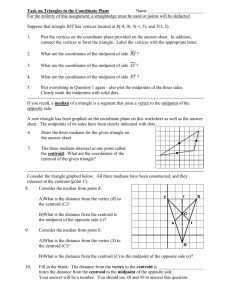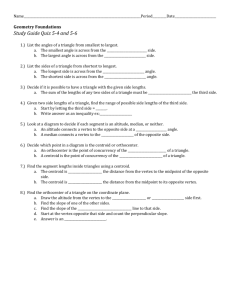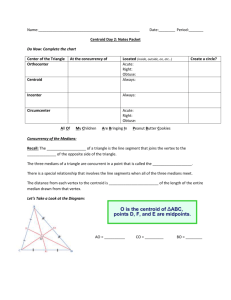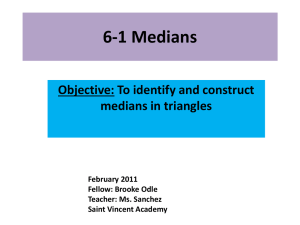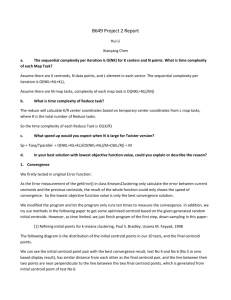FERRARELLO - Mathematics Education Directory
advertisement
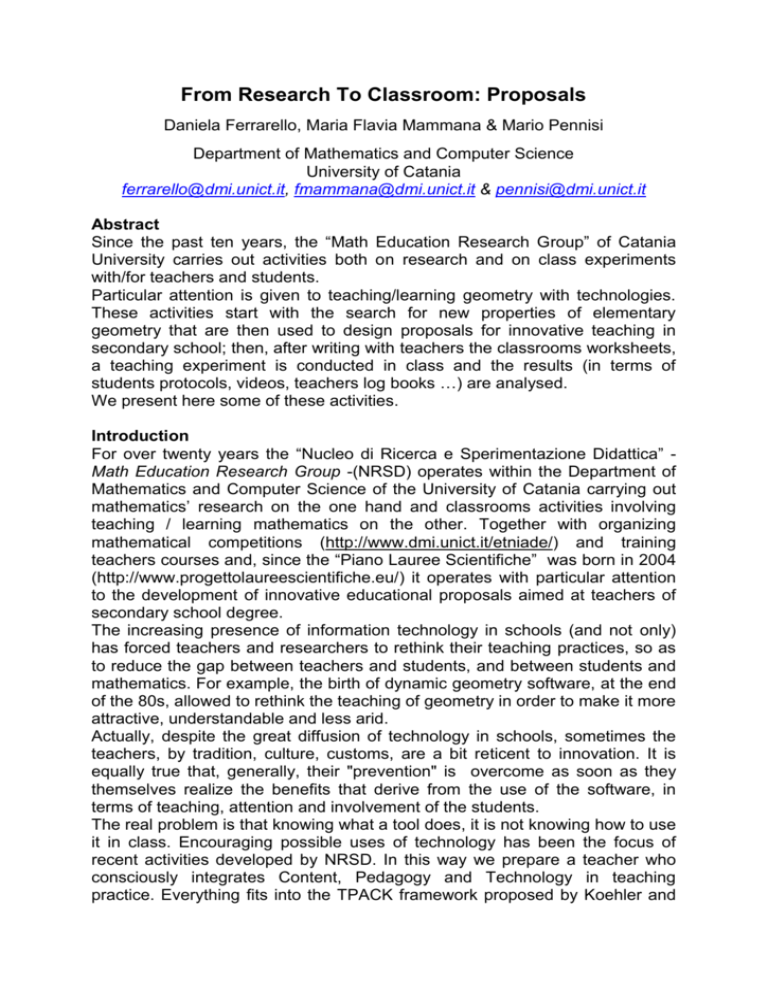
From Research To Classroom: Proposals Daniela Ferrarello, Maria Flavia Mammana & Mario Pennisi Department of Mathematics and Computer Science University of Catania ferrarello@dmi.unict.it, fmammana@dmi.unict.it & pennisi@dmi.unict.it Abstract Since the past ten years, the “Math Education Research Group” of Catania University carries out activities both on research and on class experiments with/for teachers and students. Particular attention is given to teaching/learning geometry with technologies. These activities start with the search for new properties of elementary geometry that are then used to design proposals for innovative teaching in secondary school; then, after writing with teachers the classrooms worksheets, a teaching experiment is conducted in class and the results (in terms of students protocols, videos, teachers log books …) are analysed. We present here some of these activities. Introduction For over twenty years the “Nucleo di Ricerca e Sperimentazione Didattica” Math Education Research Group -(NRSD) operates within the Department of Mathematics and Computer Science of the University of Catania carrying out mathematics’ research on the one hand and classrooms activities involving teaching / learning mathematics on the other. Together with organizing mathematical competitions (http://www.dmi.unict.it/etniade/) and training teachers courses and, since the “Piano Lauree Scientifiche” was born in 2004 (http://www.progettolaureescientifiche.eu/) it operates with particular attention to the development of innovative educational proposals aimed at teachers of secondary school degree. The increasing presence of information technology in schools (and not only) has forced teachers and researchers to rethink their teaching practices, so as to reduce the gap between teachers and students, and between students and mathematics. For example, the birth of dynamic geometry software, at the end of the 80s, allowed to rethink the teaching of geometry in order to make it more attractive, understandable and less arid. Actually, despite the great diffusion of technology in schools, sometimes the teachers, by tradition, culture, customs, are a bit reticent to innovation. It is equally true that, generally, their "prevention" is overcome as soon as they themselves realize the benefits that derive from the use of the software, in terms of teaching, attention and involvement of the students. The real problem is that knowing what a tool does, it is not knowing how to use it in class. Encouraging possible uses of technology has been the focus of recent activities developed by NRSD. In this way we prepare a teacher who consciously integrates Content, Pedagogy and Technology in teaching practice. Everything fits into the TPACK framework proposed by Koehler and Mishra that underline the interplay of the three components, Technological, Pedagogical and Content Knowledge, in the learning and teaching process. “Good teaching is not simply adding technology to the existing teaching and content domain. Rather, the introduction of technology causes the representation of new concepts and requires the development of sensitivity to the dynamic and transactional relationship between all three components suggested by the TPACK framework” (Koehler & Mishra, 2008). Here it follows the declinations of T, P and C in relation to the proposals that we have developed. The proposals relate to the Euclidean geometry, often disregarded by teachers and therefore not appreciated by the students. The working method of each activity was similar: we used a double-laboratory (Ferrarello&al. 2013a), one for the teachers, led by the authors -where altogether write the classroom worksheets- and one for students, guided by their teachers –where students use the prepared worksheets. Both laboratories are based on the idea of mathematical laboratory1 (Chiappini, 2007). T for Technology The Technological Knowledge, (TK) is defined as the “Knowledge about certain ways of thinking about, and working with technology, tools and resources” (Koehler & Mishra, 2009). In the activities we proposed we use a Dynamic Geometry System (DGS), usually Cabri Geometre or Geogebra. DGS have transformed the teaching of geometry, allowing the student to explore, conjecture, verify properties. In the "first laboratory" we try to transfer to the teachers participating in the drafting of the sheets the importance of this artifact in the construction of knowledge. Rather than using it as a way to show the properties, we use it as a tool to build knowledge: the student, following a path designed specifically, collaborating with peers, becomes a builder of his knowledge. So they stimulate different competences: from learning to learn to the citizenship competence. P for Pedagogy The Pedagogical Knowledge, (PK) is defined as the “Teachers’ deep knowledge about the processes and practices or methods of teaching and learning” (Koehler & Mishra, 2009). A common basis for all activities is the centrality of the student in the learning process. That's why the pedagogical theories we used in our activities have in common the active role of the students, who does not passively listen to told lectures, but they are the protagonists in the construction of their knowledge. From a pedagogical point of view in every activity we focused particularly on one or more aspects of the student, as described below. The student's hands: Dewey and the laboratory of Mathematics This method was used in each project, but “From particular to general”, addressed only to a few students, guided directly by the authors. 1 As already mentioned, our activities are based on the teaching laboratory. In particular, we get inspiration from Dewey’s theory of "learning by doing" (Dewey, 1916), according to which you learn especially "getting your hands dirty." The pedagogic theory has been inflected into practice by the laboratory of Mathematics (Chiappini, 2007), understood not only as a physical place (in our case the computer lab) but also as a phenomenological space, where, doing and seeing the others do, students re-discover mathematics. For example, in the activity on geometric transformations students have reconstructed the various transformations and only after have built them, they arrived at their definitions. In the project on centroids of polygons and polyhedra we did more: the students worked as young mathematicians, discovering a new theory, starting from simple cases to get a more complex theory, in a process from particular to general. The student’s eyes: Vygotsky and visual intelligence All projects have been carried out with the aid of a dynamic geometry software (DGS), in the Vygotskijan perspective of the concept (mathematician concept, in our case) mediated by the artifact (Vygotsky, 1986). The software allows to manipulate mathematical objects, by exploring them, and to view them immediately. This approach was particularly useful in the project "geometric properties and algebraic formulas", in which students “saw” algebraic formulas: they started from a geometrical proposition, translated it into images (by rectangles and squares), composed the various shapes and then landed to algebraic formulas (some special products). The artifact was a precious fellow, because through the eyes (and hands) students mastered symbols, signs, formulas of algebra, which are often dryly learned by heart, without grasping the true meaning, as they repeat in an unknown language. The student’s heart: Vygotskij and Enactivism At the end of each activity we offered a questionnaire to students. Often in these questionnaires the students talk about "this mathematics", as if this mathematics was different from the mathematics studied at school. In many cases, our approach encouraged a more attractive vision of mathematics, reaching the heart of the students, their emotional side, that is, not only the students learned, but they enjoyed theirselves. Surely this happened thank to the use of computers, for our digital natives it is always intriguing, but also to the positive climate and the environment of collaborative learning (as arised by the questionnaires). According to Vygotskij’s social theory in the zone of proximal development, in fact, the peer tutoring favors the growth of the actual development, and this growth is favored by the positive atmosphere in the classroom. In our activities pupils work independently (through the use of worksheets) and in collaboration with peers (usually in pairs). Obviously, the teacher also has a role: the attitude dictated by the principles of Enactivism, (Shulmann, 1987; Rossi, 2011). According to these theory the enthusiasm and involvement, do not depend only on the methodological choices, but also on how the teacher uses them "in action" in class. In other words, the laboratorial methodology does not work “a priori”, but it needs a precise attitude of the teacher, who should be a guide, a support, ready to suggest without revealing, to encourage, to praise, to make students correct themselves, taking advantage not only of words, but also of gestures and glances. The student’s brain: Kolb and learning styles By using hands and eyes and through the heart, we want to reach the brain, i.e. a significant learning. Our activities are in the perspective of personalized teaching, because each student has not to follow the rhythm set by the teacher, who, as just mentioned, is just a guidance and support. Students are, instead, the main actors. Students can follow their own scheduling, and they have a their own space, provided by worksheet, to express their own ideas. The worksheets, in fact, are to be completed by the students, who in some cases have also responded differently (and correctly!) respect to the expectations of the authors. Every student is different and everyone should be guaranteed the opportunity to learn, in the best way. In the project on Quadrilaterals and tetrahedra we used the spiral of learning by David Kolb (Kolb & Fry, 1975) to promote the four learning styles identified by Professor Kolb, diverging, assimilating, converging and accommodating, following the steps of experience, problem posing, theory, practice, new experience. C for Content The Content Knowledge is defined as “Teachers’ knowledge about the subject matter to be learned or taught” (Koehler & Mishra, 2009). The proposed activities in the last years were: A. Laboratory on: From particular to general B. Laboratories on geometric transformations in teaching/learning geometry C. Laboratories on geometric properties and algebraic formulas D. Laboratories on geometric loci E. Laboratories on analogies between quadrilaterals and tethaedra. Contents of each activity arise from the results reached by NRSD, to offer new and interesting topics both for students and teachers. In the following we report a summary of such contents. A. From particular to general In (Mammana et al., 2008) the concepts of centroid and median of system of points in the space, are introduced. Some properties in polygons and polyhedra are studied, and a generalization in extended system of points is reached. Some of these results are used to realize a laboratorial activity, (Ferrarello et al, 2012), allowing talented students to generalize a mathematical theory. In the following we report the contents reached by students in the lab: TRIANGLES The segment joining the vertex of a triangle with the midpoint of the opposite side is called median. The three medians of a triangle all pass through one point which divides each median into two segments such that the one containing the vertex is twice as long as the other one. The common point G to the medians of a triangle is called the centroid of the triangle. Let G be the centroid of a triangle A1A2A3,. It is: ⃗⃗⃗⃗⃗⃗⃗ 𝐺𝐴1 + ⃗⃗⃗⃗⃗⃗⃗⃗ 𝐺𝐴2 + ⃗⃗⃗⃗⃗⃗⃗⃗ 𝐺𝐴3 = 0. 1 ⃗⃗⃗⃗⃗⃗⃗1 + ⃗⃗⃗⃗⃗⃗⃗ Le P be any point of the plane. It is: ⃗⃗⃗⃗⃗ 𝑃𝐺 = (𝑃𝐴 𝑃𝐴2 + ⃗⃗⃗⃗⃗⃗⃗ 𝑃𝐴3 ). 3 QUADRILATERALS The segment joining the midpoints of two opposite sides or of the diagonals of a quadrilateral is called bimedian. The three bimedians of a quadrilateral all pass through one point and bisect one another. The common point G to the bimedians of a quadrilateral is called the centroid of the quadrilateral. ⃗⃗⃗⃗⃗⃗⃗1 + ⃗⃗⃗⃗⃗⃗⃗⃗ Let G be the centroid of a quadrilateral A1A2A3A4. It is: 𝐺𝐴 𝐺𝐴2 + ⃗⃗⃗⃗⃗⃗⃗⃗ 𝐺𝐴3 + ⃗⃗⃗⃗⃗⃗⃗⃗ 𝐺𝐴4 = 0. 1 ⃗⃗⃗⃗⃗⃗⃗1 + ⃗⃗⃗⃗⃗⃗⃗ Le P be any point of the plane. It is: ⃗⃗⃗⃗⃗ 𝑃𝐺 = (𝑃𝐴 𝑃𝐴2 + ⃗⃗⃗⃗⃗⃗⃗ 𝑃𝐴3 + ⃗⃗⃗⃗⃗⃗⃗ 𝑃𝐴4 ). 4 TETRAHEDRA The segment joining the midpoints of two opposite sides of a tetrahedra is called bimedian. The three bimedians of a tetrahedron all pass through one point and bisect one another. The common point G to the bimedians of a tetrahedron is called the centroid of the tetrahedron. ⃗⃗⃗⃗⃗⃗⃗1 + ⃗⃗⃗⃗⃗⃗⃗⃗ Let G be the centroid of a tetrahedron A1A2A3A4. It is: 𝐺𝐴 𝐺𝐴2 + ⃗⃗⃗⃗⃗⃗⃗⃗ 𝐺𝐴3 + ⃗⃗⃗⃗⃗⃗⃗⃗ 𝐺𝐴4 = 0. ⃗⃗⃗⃗⃗ = 1 (𝑃𝐴 ⃗⃗⃗⃗⃗⃗⃗1 + ⃗⃗⃗⃗⃗⃗⃗ Le P be any point of the space. It is: 𝑃𝐺 𝑃𝐴2 + ⃗⃗⃗⃗⃗⃗⃗ 𝑃𝐴3 + 4 ⃗⃗⃗⃗⃗⃗⃗ 𝑃𝐴4 ). n-SYSTEMS A set S of n distinct points of the space, with n1, is called n-system. Let Ai (i = 1, 2,…,n) be the points of S. Let P be a fixed point of the space. We call centroid of S the point G of the ⃗⃗⃗⃗⃗ = 1 ∑𝑛𝑖=1 ⃗⃗⃗⃗⃗⃗⃗ space such that 𝑃𝐺 𝑃𝐴𝑖 . 𝑛 The point G does not depend on the choice of P. A point G of the space is the centroid of an n-system S if and only if ∑𝑛𝑖=1 ⃗⃗⃗⃗⃗⃗⃗ 𝐺𝐴𝑖 = ⃗. 0 Let P be a polygon or a polyhedron with n vertices. We call system S associated with P the system whose points are the vertices of P. We call centroid of P the centroid of the system associated with P. The centroid of a triangle, of a quadrilateral, of a tetrahedron is the centroid of the associated n-system. Let S be a n-system. A nonempty subset S' of S of k points is called k𝑛 subsystem of S. There are ( ) k-subsystems of an n-system. 2 Let S be a n-system and S' be a k-subsystem of S. We call subsystem opposite to S' the subsystem S" that is the relative complement of S' with respect to S. Let S' be a k-subsystem of S, with 0<k<n/2, and G' its centroid. Let S" be the subsystem of S opposite to S' and G" its centroid. We call k-median of S relative to S' the segment G'G". Let S be the system associated with a polygon P. If P is a triangle, the 1medians of S are the medians of P. If P is a quadrilateral, the 2-medians of S are the bimedians of P, the 1-medians of S are the medians, i.e. the segments AiGi, (i = 1, 2, 3, 4) joining a vertex Ai with the centroid Gi of the triangle opposite to Ai. If P is a tetrahedron, the 2-medians of S are the bimedians of P, the 1-medians of S are the medians, i.e. the segments joining a vertex with the centroid of the opposite face. Let S be an n-system and G its centroid. In the following we will denote by S' any k-subsystem of S, with 0<k<n/2, and G' its centroid; we will denote by S" the subsystem of S opposite to S' and G" its centroid. The k-medians of S are concurrent in G. Moreover, G divides each k-median 𝐺′𝐺 𝑛−𝑘 G'G" into two parts such that ′′ = . 𝐺𝐺 𝑘 The system of centroids of the k-subsystems of S is the correspondent of the system of centroids of the (nk)-subsystems of S in the dilatation with ratio – (n-k)/k and center G. In this dilatation the centroid of a k-subsystem is the correspondent of the centroid of its opposite. The segment G'1G'2 that joins the centroids of two k-subsystems S'1, S'2 of S is parallel to the segment G"1G"2 that joins the centroids of the (nk)-subsystems opposite to S'1, S'2 . Moreover it is: 𝐺1′ 𝐺2′ 𝐺1′′ 𝐺2′′ = 𝑛−𝑘 𝑘 . If n is even and k=n/2, G is the center of symmetry of the system of centroids of the k-subsystems of S. Moreover, the segment G'1G'2 that joins the centroids of two k-subsystems S'1, S'2 of S is parallel and equal to the segment G"1G"2 that joins the centroids of the k-subsystems opposite to S'1, S'2. The centroid of S is also the centroid of the system of centroids of the ksubsystems of S. APPLICATIONS TO TRIANGLES The three medians of a triangle all pass through one point which divides each median into two segments such that the one containing the vertex is twice as long as the other (it follows from theorem 6). A triangle T and its medial triangle T' (triangle with vertices the midpoints of the edges of T) have the same centroid G. Moreover T' is the correspondent of T in the dilatation with ratio 1/2 and center G. The segment joining the midpoints of two sides of a triangle T is parallel to the third side and half as long as that third side. Then, the sides of T' are half as long as those of T, the perimeter of T' is half of that of T and the area is one fourth of that of T. APPLICATIONS TO TETRAHEDRA The three bimedians of a tetrahedron all pass through one point and bisect one another. The quadrilateral with vertices the midpoints of two pairs of opposite sides is a parallelogram. The four medians of a tetrahedron meet in the centroid G of the tetrahedron. Moreover G divides each median into two segments such that the one containing the vertex is three times as long as the other (Commandino’s theorem). A tetrahedron T and its medial tetrahedron T' (whose vertices are the centroids of the faces of T) have the same centroid G. Moreover T' is the correspondent of T in the dilatation with ratio 1/3 and center G. The faces and the edges of T' are parallel to the faces and the edges of T. B. Teaching/learning geometric transformations The activity arise from (Ferrarello, 2012). In the experimentation in class (Ferrarello et al., 2014a) we dealt with some isometries and with homothetic transformations, highlighting the main properties. We also examined some significant applications of the geometric transformations to the medial triangle of a triangle, the Euler line, the orthic triangle, and the Feuerbach circle. The following are the properties examined by students in labs. A triangle ABC corresponds to its medial triangle in the homothetic transformation with centre the centroid of ABC and ratio -0.5. The perimeter of the medial triangle of a triangle ABC is half the perimeter of ABC and the area of the medial triangle of ABC is a quarter of the area of ABC. A triangle and its medial triangle have the same centroid G. The circumcentre O of a triangle coincides with the orthocentre of its medial triangle. The orthocentre H of a triangle belongs to the line GO (line of Euler) and moreover G divides the segment OH in two parts such that GH = 2OG. The orthocentre of a triangle coincides with the incentre of its orthic triangle; In a triangle ABC, the vertices of its medial triangle, the vertices of its orthic triangle and the Euler points (midpoints of AH, BH and CH) are all on a circle (circle of Feuerbach). C. Geometric properties and algebraic formulas In (Anzalone et al., 2003), some propositions of Euclid’s Elements, Book II, are analized, and some other properties are created “ad hoc”. A bridge between abstract algebraic formulas and more visible geometric properties is built. The first property we dealt with is the following GEOMETRIC PROPERTY ALGEBRAIC PROPERTY P1: If there are two straight lines, and one of them is cut into any number of segments a (b c d) ab ac ad whatever, then the rectangle contained by the two straight lines equals the sum of the rectangles contained by the uncut straight line and each of the segments. The other plane properties, as in (Ferrarello et al., to appear) are the square of a binomial (sum and difference), the difference of two squares. And the space properties concern the cube of a binomial (sum and difference), the sum of two cubes and the difference of two cubes. D. Geometric loci In (Ferrarello et al., 2014b) it is used a property of the centroids to study some geometric loci: of centroids for cyclic quadrilaterals, of anticentres for cyclic quadrilaterals, of Monge points of tetrahedra. In particular, we determine some properties of the nine-point circle of a triangle. Starting from this paper, a laboratorial activity for students is given (Ferrarello et al, to appear). In particular, the students studied loci generated as it follows: let γ be a circle with centre O and radius r; fix n points on γ, with n=1, 2, 3 and consider a generic point P of γ; we define a point L that depends on P and study the locus λ described by L when P moves on γ. In the following table we report the cases we examined. n=1 n=2, a Let A be a fixed point of and P a Let A and B be two distinct points generic point of . Let L be the of , P be a generic point of . middle point of the segment AP. When P moves on , the locus λ The locus λ described by L when P described by the centroid L of ABP moves on is a circle with radius is the circle with radius r/3 and r/2 and centre the middle point of centre the point C of the segment OM such that CM=1/3OM, where AO M is the middle point of AB. n=2, b n=2, c Let A and B be two distinct points Let A and B be two distinct points of , P be a generic point of . of , P be a generic point of . When P moves on , the locus λ When P moves on , the locus λ described by the orthocentre L of described by the incentre L of ABP ABP is the circle that is symmetric is the done by two arcs of the circles through A, B and with of with respect to AB. centres the common points to and to the axes of AB. n=2, d n=3, a Let A and B be two distinct points Let A, B and C be three distinct of , P be a generic point of . points of . Let P be a generic When P moves on , the locus λ point of . When P moves on , the described by the circumcentre L of locus λ described by the anticentre ABP is one point, the centre O of . L of ABCP is the Feuerbach circle of the triangle ABC. n=3, b Some more loci, a Let A, B and C be three distinct Let A and P be points of γ. The points of . Let P be a generic locus described by the point of . When P moves on , the locus λ described by the centroid L of ABCP is the Feuerbach circle of the medial triangle of ABC. Some more loci, b Let A and P be points of γ, t the tangent line to γ in P and L the foot of the perpendicular to t from A. The locus described by L when P moves on γ is a bicircular quartic with one cusp in A (Cardioid). orthocentre L of the triangle AOP, when P moves on γ, is a cubic with a node in O (Strophoid). Some more loci, c Let AB be a diameter of γ. Let r be a perpendicular line to AB. Let P a point of γ and R the point in which AP meets r. Let L the midpoint of PR. The locus described by L when P moves on γ depends on r, but it is in general a cubic. E. Analogies between quadrilaterals e tetraedra In (Mammana, Micale, Pennisi, 2008) it is shown the existence of a surprising analogy between quadrilaterals and tetrahedra. We determine some properties that hold for both families of figures relative to bimedians, centroid, medians, circumcentre, anticentre and Monge point. The analogy between quadrilaterals and tetrahedra, allow us to develop a stimulating topic of three dimensional geometry in parallel with two dimensional geometry. The topic was presented as a research and discovery activity, (Mammana et al., 2012; Mammana et al. 2010; Ferrarello et al., 2014c) with the help of a dynamic geometry software, such us Cabri, both the two dimensional version (Cabri Géomètre II Plus) and the three dimensional one (Cabri 3D). In the following table we summarize the analogies and the properties we handled in our activity. QUADRILATERALS Q is a convex quadrilateral with vertices A, B, C, D. The points A, B, C, D are such that any three of them are noncollinear. The vertices detect six segments AB, BC, CD, DA, AC, BD, that are called edges. The edges of Q are the four sides and the two diagonals. Two edges are said to be opposite if they do not have common vertices. They are opposite edges: AB and CD, BC and DA, AC and BD, that is, either two opposite sides or the two diagonals. We call faces of Q the triangles TETRAHEDRA T is a tetrahedron with vertices A, B, C, D. The points A, B, C, D are non coplanar. The vertices detect six segments AB, BC, CD, DA, AC, BD, that are called edges. Two edges are said to be opposite if they do not have common vertices. They are opposite edges: AB and CD, BC and DA, AC and BD. We call faces of T the triangles determined by three vertices of Q. There are four faces: ABC, BCD, CDA, DAB. A vertex and a face are said to be opposite if the vertex does not belong to the face. For each vertex there is one and only one opposite face. The segment joining the midpoints of two opposite edges of Q is called bimedian of Q. Q has three bimedians, two relative to a pair of opposite sides and one relative to the diagonals. Theorem 1. The three bimedians of a quadrilateral all pass through one point. The point G common to the three bimedians of Q is called the centroid of Q. Theorem 2. The centroid bisects each bimedian. The segment joining a vertex of Q with the centroid of the opposite face is called median of Q. Q has four medians. Theorem 3. The four medians of a quadrilateral meet in its centroid. Theorem 4. The centroid of a quadrilateral divides each median in the ratio 1:3, the longer segment being on the side of the vertex of Q. determined by three vertices of T. There are four faces: ABC, BCD, CDA, DAB. A vertex and a face are said to be opposite if the vertex does not belong to the face. For each vertex there is one and only one opposite face. The segment joining the midpoints of two opposite edges of T is called bimedian of T. T has three bimedians. Theorem 1. The three bimedians of a tetrahedron all pass through one point. The point G common to the three bimedians of T is called the centroid of T. Theorem 2. The centroid bisects each bimedian. The segment joining a vertex of T with the centroid of the opposite face is called median of T. T has four medians. Theorem 3. The four medians of a tetrahedron meet in its centroid (Commandino’s Theorem). Theorem 4. The centroid of a tetrahedron divides each median in the ratio 1:3, the longer segment being on the side of the vertex of T. Brief Conclusions The approach we used in the past 10 years has been always refined and sewn according to the topic and teachers participating in the activity. Teachers showed enthusiasm and interest in collaborating with us and with colleagues from other schools. Students involved in the experimentations were happy to join the activities and to be part of their knowledge construction process. More to come! References Anzalone, A., Margarone, D., & Micale, B. (2003): Euclide al computer: proprietà geometriche e formule algebriche. Catania: Casa Editrice La Tecnica della Scuola. Chiappini, G. (2007): Il laboratorio didattico di matematica: riferimenti teorici per la costruzione. Innovazione educativa, Inserto allegato al numero 8, 9-12. Dewey, J. (1916): Democracy and education: an introduction to the philosophy of education. Free Press; Reprint edition (February 1, 1997) Ferrarello, D. (2012): Trasformazioni geometriche e proprietà dei triangoli. L'educazione matematica Vol.1. Ferrarello, D., Mammana, M. F. & Pennisi, M. (2012): From particular to general: a research laboratory on the centroids of plane and space figures. Proceedings of ICME12, Seoul, Korea, 2279 – 2288. Ferrarello, D., Mammana,M.F. & Pennisi,M. (2013a): Teaching by doing. Quaderni di ricerca in didattica / mathematics (QRDM). 23, 1. 466-475. Ferrarello D, Mammana M. F. & Pennisi M (2013b): Using DGS to introduce algebra properties. In: EDS Faggiano E & Montone A, Proceedings of ICTMT 11. 137-142, Bari. Ferrarello D, Mammana M.F. & Pennisi M (2014a): Teaching/learning geometric transformations in high-school with DGS. The International Journal For Technology In Mathematics Education. vol. 21, p. 11-18. Ferrarello, D., Mammana, M.F. & Pennisi, M. (2014b): Geometric loci and homothetic transformations. International Journal of Mathematical Education in Science and Technology. 45, 2. Ferrarello, D., Mammana,M.F. & Pennisi,M. (2014c): From 2d to 3d geometry: discovering, conjecturing, proving. Proceedings of the 12th International Conference of The Mathematics Education into the 21st Century Project The Future of Mathematics Education in a Connected World. Montenegro, 21-26 September, 2014 Ferrarello, D., Mammana,M.F. & Pennisi,M. (to appear): Studying geometric loci. In proceedings of CIEAEM2015. Koehler, M.J., Mishra, P. (2008): Introducing Technological Pedagogical Knowledge. Handbook of Technological Pedagogical Content Knowledge for Educators, Edited by AACTE Committee on Innovation and technology, AACTE and Routledge, NY. Koehler, M. J., & Mishra, P. (2009): What is technological pedagogical content knowledge? Contemporary Issues in Technology and Teacher Education, 9(1), 60-70. Kolb, D.A., & Fry, R. (1975): Toward an applied theory of experiential learning. C. Cooper (ed.), Theories of Group Process, London: John Wiley. Mammana M.F., Micale B., and Pennisi M. (2008): On the centroids of polygons and polyhedral. Forum Geometricorum, 8, 121-130. Mammana, M. F. & Pennisi, M. (2010): Dragging quadrilaterals into tetrahedra. In Yang, W. (ed) ATCM 2011, Mathematics and Technology, VA, USA: Blacksburg, 373-384. Mammana, M. F., Micale, B. & Pennisi, M. (2012): Analogy and dynamic geometry system used to introduce three-dimensional geometry. International Journal of Mathematical Education in Science and Technology, 43 (6), 818-830 Rossi, P.G. (2011): Didattica Enattiva. Complessità, teorie dell'azione, professionalità docente. Franco Angeli, Milano Shulman, L. (1987): Knowledge and Teaching: Foundations of the New Reform. Harvard Educational Review. Vygotskij, L.S. (1986). Thought and Language. The MIT Press; revised edition.

